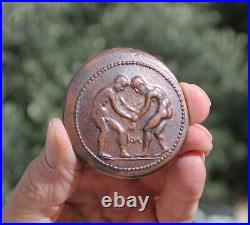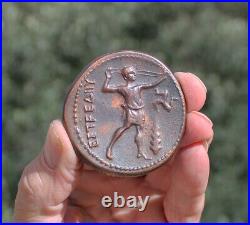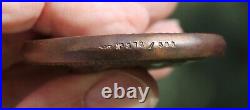



This medal is a part of my French medals offer. Visit my page with the offers, please. You will find many interesting items related to this subject. This medal has been minted in France to commemorate a beautiful coin, (the silver stater), of the ancient Aspendos in Pamphylia (contemporary Turkey), V century BC. This medal has been designed minted in 500 pieces. This one has the number 272/500 on the rim. The site is located 7 kilometres (4.3 mi) northeast of central. ???????? , Pamphylía, modern pronunciation Pamfylía. Was a former region in the south of. It was bounded on the north by. And was therefore a country of small extent, having a coast-line of only about 120 km (75 miles) with a breadth of about 50 km (30 miles). Under the Roman administration the term Pamphylia was extended so as to include Pisidia and the whole tract up to the frontiers of. And in this wider sense it is employed by. Aspendos was one of the earliest cities to mint coins. It began issuing coinage around 500 BC, first. “The hoplite on the obverse represents the soldiery for which Aspendus was famous in antiquity, ” the reverse frequently depicts a. The legend appears on early coins as the abbreviation?? or????? ; later coinage has?????????? , the adjective from the city’s local (Pamphylian) name Estwedus. History extends from archaic Greek to late Roman times. Two wrestlers, nude, beginning to grapple with each other. Slinger standing to right, preparing to launch sling-bolt;??? F?????? to left, triskeles. Diameter – 64 mm, (ca 2½). Weight – 129.40 gr, (4.56 oz). Metal – bronze, authentic patina. Aspendos was an ancient city in. Located about 40 km east of the modern city of. It was situated on the. About 16 km inland from the. It shared a border with, and was hostile to. Some scholars associate the city’s name with “Azatiwadaya”. The known city of that name was founded by. On his eastern frontier, at. According to later tradition, Aspendos was founded rather earlier by Greeks who may have come from. The wide range of its coinage throughout the ancient world indicates that, in the 5th century BC, Aspendos had become the most important city in Pamphylia. At that time, according to. The Eurymedon River was navigable as far as Aspendos, and the city derived great wealth from a trade in salt, oil and wool. Aspendos did not play an important role in antiquity as a political force. Its political history during the colonisation period corresponded to the currents of the. Within this trend, after the colonial period, it remained for a time under Lycian hegemony. In 546 BC it came under. The fact that the city continued to mint coins in its own name, however, indicates that it had a great deal of freedom even under the Persians. Led an Athenian navy against a Persian navy in the. Battle of the Eurymedon. Aspendos then became a member of the. The Persians captured the city again in 411 BC and used it as a base. In 389 BC Thrasybulus of. In an effort to regain some of the prestige that city had lost in the. Anchored off the coast of Aspendos in an effort to secure its surrender. Enraged, the Aspendians stabbed and killed Thrasybulus in his tent. Marched into Aspendos in 333 BC after capturing. The citizens sent envoys asking him not to garrison soldiers there. After reaching this agreement Alexander went to. Leaving a garrison there on the city’s surrender. Going back through Sillyon, he learned that the Aspendians had failed to ratify the agreement their envoys had proposed and were preparing to defend themselves. Alexander marched to the city immediately. When they saw Alexander returning with his troops, the Aspendians, who had retreated to their acropolis, again sent envoys to sue for peace. In 190 BC the city surrendered to the. And the corrput magistrate. Later pillaged its artistic treasures. It was ranked by. The third city of Pamphylia, and in. Times seems to have been known as Primopolis. Toward the end of the Roman period the city began a decline that continued throughout Byzantine times, although in medieval times it was evidently still a strong place.

